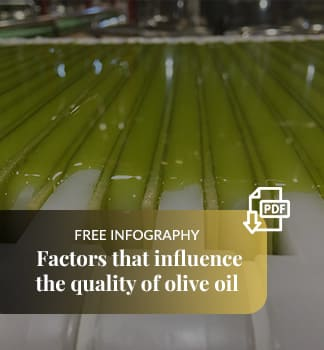Student undergoing training in the ESAO Olive Oil Sommelier Certification
Extra Virgin Olive Oil, known for its sublime flavor and aroma, can sometimes exhibit defects that affect its quality and sensory experience. In this article, we will explore the defective aromas that may arise in olive oil, and how the "Defect Aroma Wheel" can be an invaluable tool in their identification.
Aromas that Challenge the Experience
While ideal Extra Virgin Olive Oil should dazzle with its freshness and complexity, we acknowledge that there are occasions when it may present unpleasant aromas.
These defective aromas result from various factors, from improper storage to late olive harvesting, the impurity of the mill, or a lack of good practices in the field, production, and marketing.
The Defect Aroma Wheel: An Indispensable Guide
Just like the aroma wheel that guides us through the exquisite nuances of Extra Virgin Olive Oil, there exists a counterpart designed to identify and describe defective aromas. This tool becomes an indispensable guide for tasters and lovers of Extra Virgin Olive Oil, enabling the precise detection of potential defects.

Sensory Wheel for Olive Oil Defects
Key Defects to Know
Rancidity: This is one of the most common defects and manifests as a stale and unpleasant odor and taste. It can be caused by oil oxidation due to exposure to air and light.
-
Vinegary: A sour and pungent aroma and taste indicate the presence of acetic acid. This may result from unwanted fermentation or improper storage.
-
Wet Wood: Characterized by an aroma reminiscent of a wet olive pit, this defect usually occurs in oils where the olives were previously frozen before milling.
-
Musty or Dampness: This defect emits an odor of moisture or mold, possibly indicating the presence of spoiled olives.
-
Winery: Refers to a smell and taste of sour wine or vinegar, which can arise when olives ferment before milling.
Importance of Recognizing Defects
Identifying defective aromas in olive oil is crucial to maintain high-quality standards and ensure an optimal taste experience. Additionally, this skill is essential for those involved in the production and marketing of high-quality olive oil.
A Step towards Excellence
By understanding and recognizing defective aromas in olive oil, we move closer to excellence in the appreciation and production of this precious golden liquid. The defect aroma wheel thus becomes an essential tool for those seeking to refine their palate and elevate their experience with Extra Virgin Olive Oil.
Within our training, the significance of defects is crucial. Continuous training and the ability to detect when an Extra Virgin Olive Oil is defective will help us determine if we are working effectively or assist us in deciding which oil to buy and at what price.
Visit ESAO's website in case you find it interesting to educate yourself in the field of olive oil.
Students from ESAO in the Olive Oil Sommelier Certification
Remember, by exploring the defect aroma wheel, we are taking confident steps towards excellence in the appreciation and production of Extra Virgin Olive Oil. Discover a new world of flavors and aromas in every drop of Extra Virgin Olive Oil!
Stay informed about olive oil trends to adapt to market changes and capitalize on opportunities.
.png)


